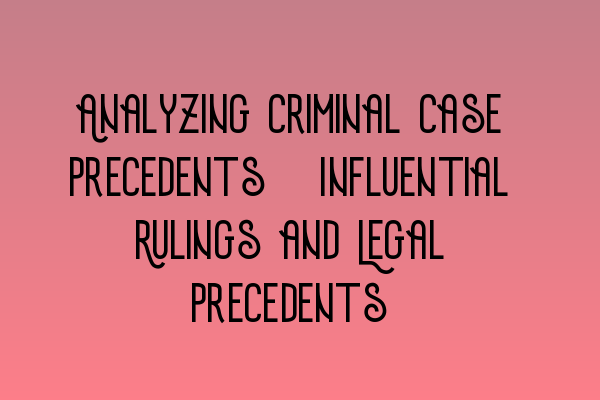Analyzing Criminal Case Precedents: Influential Rulings and Legal Precedents
As a criminal law practitioner, it is essential to have a solid understanding of case precedents and how they influence the legal landscape. Analyzing and studying influential criminal case precedents not only helps in building a strong legal argument but also ensures that justice is served.
In this blog post, we will delve into the world of criminal case precedents, exploring their significance, and providing valuable insights into analyzing these rulings effectively.
What are Criminal Case Precedents?
Criminal case precedents, also known as legal precedents, are the rulings and decisions made by higher courts that establish a legal principle or rule. These precedents serve as a binding authority for similar future cases, ensuring consistency and fairness in the legal system.
When analyzing criminal case precedents, it is crucial to understand the hierarchy of courts. In the UK, the highest court is the Supreme Court, followed by the Court of Appeal and the Crown Court. Lower-level courts, such as Magistrates’ Courts, are not considered binding authorities but can still be persuasive.
The Significance of Analyzing Criminal Case Precedents
Studying and analyzing criminal case precedents offers several benefits to legal professionals:
- Establishing legal arguments: Precedents help shape and strengthen legal arguments by providing a foundation of established legal principles and interpretations.
- Identifying trends and patterns: Analyzing multiple precedents allows practitioners to identify trends, patterns, and shifts in legal interpretations, aiding in the development of effective legal strategies.
- Spotting weaknesses and gaps: In-depth analysis of precedents helps identify any weaknesses or gaps in existing laws, enabling lawyers to advocate for necessary reforms or amendments.
- Ensuring consistency and fairness: Consistency in applying the law is crucial to maintaining a fair and just legal system. Analyzing precedents helps ensure that legal principles are consistently interpreted and applied.
Tips for Analyzing Criminal Case Precedents
Effectively analyzing criminal case precedents requires a systematic approach. Here are some valuable tips to enhance your analysis:
- Read the full judgments: While summaries and extracts may provide a quick overview, it is crucial to read the full judgments to gain a comprehensive understanding of the legal principles and reasoning.
- Identify key facts and legal issues: Pinpointing the key facts and legal issues addressed in the precedent will help you determine its relevance to your case and identify any distinguishing factors.
- Consider obiter dicta: Obiter dicta refers to the judge’s remarks or comments that are not directly relevant to the specific legal issue at hand but still provide valuable insights. Consider these remarks when analyzing precedents.
- Examine the court’s reasoning: Understanding the court’s reasoning and the legal principles applied is essential. Look for any dissenting opinions or alternative viewpoints expressed by the judges.
- Compare and contrast: Comparing and contrasting precedents can help identify inconsistencies or conflicting interpretations, allowing you to craft a more persuasive argument.
Conclusion
Analyzing criminal case precedents is an indispensable skill for criminal law practitioners. It not only aids in building strong legal arguments but also ensures consistency and fairness in the legal system. By understanding the significance of these influential rulings and following effective analysis techniques, legal professionals can effectively navigate the intricacies of criminal law.
For further preparation and practice, you may also find the following articles helpful:
